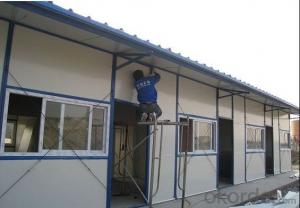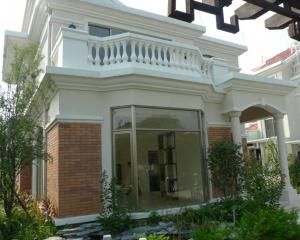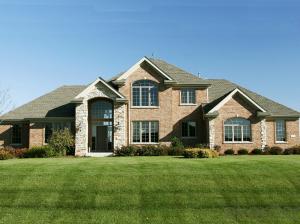Steel sandwich panel houses, mobile homes
OKorder Service Pledge
OKorder Financial Service
You Might Also Like
Packaging & Delivery
| Packaging Detail: | Standard export seaworthy packing |
| Delivery Detail: | Within 20 days after receiving the deposit |
Specifications
1,Simple but generous appearance
2,longevity and recyclable
3,Simple but generous appearance
4,longevity and recyclable
Portable house specification:
Materials:
portable house
| 1. | Steel frame: | high quality steel structure 4mm steel profile |
| 2. | wall panel: | 1) 50mm/75mm/100mm sandwich board( with EPS,PU for its interlayer) |
| 2) Cement &EPS Sandwich panel | ||
| 3. | roof panel: | 1) 50mm/75mm/100mm sandwich board(with EPS,PU for its interlayer) |
| 2) Color-glazed roof sheet | ||
4. | windows: | Aluminium Alloy window or plastic steel windows |
| 5. | Doors: | sandwich board door or Aluminium Alloy door |
| 6. | Bathroom: | it will be equipped with one toilet bowl, one wash basin, one shower equipment.( alternative). |
| 7. | Kitchen: | it will be equipped with one kitchen cabinet( alternative) |
| 8. | Electricity: | we will supply all the electricity system and equipment( alternative) |
| 9. | Color: | you can choose any color you like.(both for the outside and inside) |
Detailed Product Description
Prefabricated steel framed buildings, portable cabins, kitset homes, emergency shelter and housing
portable house
portable house use light steel as its framework, material is sandwich panel, totoal new conception and economical and environmental protected house. Which aslo called prefabricated houses.
The advantage of portable shelter: can be assembly and disassembly at will, is convient to transport and move. can be assembly and disassembly conveniently and quickly. it is fit to locate in hillside, hill, grassland, desert, riverside and temporary houses when
construction and earthquake and as blinds, etc.
the area of the house can be 15-160m2, it is clean, can be to use for 20 years for its good stability and durablity. Its appearance beauful, we can make as customers’ requirements, has good heat preservation and insulation, earthquake proof, which has not only high value in use, but also good visual value.
Add: 1. We can supply you with reasonable and competitive price and good quality products.
2.If you are interested in any of products, please contact us for more information
- Q:Can container houses be designed to have a large outdoor living area?
- Container houses have the potential to feature a generous outdoor living area. Although they are typically smaller than conventional houses, they can still offer a substantial amount of outdoor space when designed effectively. One popular approach is to combine multiple containers or expand the living area by incorporating additional structures like decks, patios, or pergolas. Architects and designers can create open and spacious outdoor areas by strategically stacking or arranging containers. This can be achieved by removing one or more sides of the container, creating an open space that seamlessly connects the indoor and outdoor areas. Furthermore, containers can be modified to include sliding or folding doors that fully open up to expand the living space outdoors. Moreover, container houses can include various outdoor features that enhance the overall living experience. These features may consist of landscaping elements like gardens, lawns, or even swimming pools. By thoughtfully considering the layout, orientation, and placement of the containers, it is possible to maximize the available outdoor space and create a large and comfortable outdoor living area. Ultimately, the design possibilities for container houses are boundless, limited only by imagination and budget. With careful planning and design, container houses can indeed offer a spacious outdoor living area, providing homeowners with the opportunity to enjoy the outdoors while residing in a distinctive and sustainable dwelling.
- Q:Can container houses withstand extreme weather conditions?
- Indeed, container houses are specifically designed to endure even the harshest weather conditions. Typically crafted from steel shipping containers known for their exceptional durability and ability to withstand harsh environments, these houses are constructed to withstand heavy loads, including being stacked during transportation, and are engineered to resist the impacts of rough seas and powerful winds. To enhance their resilience against extreme weather, container houses can undergo modifications. For example, insulation can be added to regulate temperature and prevent heat loss during cold winters or excessive heat during hot summers. Furthermore, reinforced windows and doors can be installed to provide additional protection against strong winds and storms. Additionally, container houses can be designed to resist flooding by either elevating them on stilts or utilizing a raised foundation. This strategic approach minimizes the risk of water damage during heavy rainfall or flooding events. While it is true that no structure can be completely impervious to extreme weather, container houses are specifically engineered to be robust and durable, making them highly suitable for enduring a wide range of weather conditions.
- Q:Are container houses suitable for artists' studios or workshops?
- Artists can indeed find container houses suitable for their studios or workshops. There are several reasons why container houses make a great choice for artists. To begin with, container houses offer a cost-effective solution for artists who need a dedicated workspace. Renting or constructing traditional studio or workshop spaces can be quite expensive, especially in urban areas. Container houses provide a more affordable alternative, allowing artists to save money and invest more in their art. Moreover, container houses are highly versatile and can be easily customized. Artists can easily modify the interior of a container to create the ideal space for their specific requirements. They can add windows for natural light, insulation for temperature control, and partition walls for separate work areas. Containers can be transformed into spacious and well-lit studios or workshops that cater to various artistic practices. Furthermore, container houses are portable and can be easily moved or transported to different locations. This mobility can be advantageous for artists who need to work in different environments or travel for exhibitions or residencies. Being able to relocate their workspace allows artists to adapt to changing needs and explore new creative opportunities. Additionally, container houses are eco-friendly as they are repurposed shipping containers. By utilizing existing structures, artists contribute to sustainable practices by reducing waste and minimizing their carbon footprint. However, it's important to consider that container houses may have certain limitations. Size can be a constraint as containers come in standard dimensions, making it challenging for artists with large-scale or messy projects to work within these constraints. Moreover, noise insulation might be a concern, particularly for artists using loud equipment or musical instruments. In conclusion, container houses offer numerous benefits for artists' studios or workshops, including affordability, customization options, portability, and environmental sustainability. They provide a unique and innovative solution for artists seeking a dedicated space to create. With careful planning and consideration, container houses can be a perfect fit for many artists' needs.
- Q:Are container houses more affordable than traditional houses?
- Yes, container houses are generally more affordable than traditional houses. This is because containers are readily available, relatively inexpensive to purchase, and require less labor and time to construct compared to traditional housing materials. Additionally, container houses are highly versatile, allowing for cost-effective customization and potential savings on energy consumption.
- Q:Can container houses be designed with green roofs?
- Yes, container houses can be designed with green roofs. Green roofs, also known as living roofs or eco-roofs, are designed to have vegetation planted on top of the building structure. These roofs provide numerous environmental benefits, including insulation, stormwater management, and improved air quality. Container houses, made from repurposed shipping containers, can accommodate green roofs just like any other traditional building. However, there are some considerations to take into account when designing green roofs for container houses. First, the structural integrity of the container house needs to be assessed to ensure it can support the additional weight of a green roof. Green roofs can be quite heavy, especially when soil, plants, and water are added. Reinforcements may be required to ensure the container can withstand the load. Second, proper waterproofing and drainage systems are essential to prevent water leakage into the container structure. Green roofs retain water, so it is crucial to have a well-designed system to manage excess water and avoid damage to the container. Third, container houses may have limited space available for a green roof, depending on the size and configuration of the containers. Designers and architects need to carefully plan and optimize the available space to create a functional and aesthetically pleasing green roof. Lastly, the selection of plants for the green roof should be chosen carefully, considering the local climate and the weight limitations of the container structure. Drought-resistant and lightweight plants are often preferred for container house green roofs. With proper planning, design, and implementation, container houses can indeed incorporate green roofs. This combination can contribute to sustainable living by maximizing energy efficiency, reducing environmental impact, and creating a harmonious connection with nature.
- Q:Are container houses suitable for retail stores?
- Yes, container houses can be suitable for retail stores. They offer several advantages such as affordability, durability, and mobility. Container houses can be customized to meet the specific needs of a retail store, providing a unique and trendy shopping experience for customers. Additionally, the compact size of containers allows for easy transportation and relocation, making it convenient for businesses to adapt to changing market demands or relocate to different areas.
- Q:How much height does the height of the fence of the villa terrace?
- The railing shall be made of sturdy, durable material and capable of withstanding the horizontal load specified in the load specification
- Q:Can container houses be designed to have a minimalist interior design?
- Certainly, container houses can be designed with a minimalist interior. The simplicity and versatility of container structures lend themselves well to minimalist aesthetics. By carefully choosing materials, colors, and furniture, it is possible to create clean lines, open spaces, and a sense of simplicity within a container house. To achieve a minimalist interior design, it is crucial to prioritize functionality and declutter the space. This can be accomplished by selecting multipurpose furniture that serves various functions and eliminates the need for excessive pieces. In addition, employing built-in storage solutions and concealed cabinets can help maintain an organized space that is free from visual clutter. Regarding the color palette, a minimalist interior design often relies on neutral tones such as white, beige, or gray. These colors foster an open and airy atmosphere while directing attention towards the simplicity of the space. However, pops of color can be introduced through accent pieces or artwork to add visual interest and personalize the design. Lighting is another essential aspect of minimalist design. Maximizing natural light by incorporating large windows or skylights helps create a sense of openness and connection to the surrounding environment. Furthermore, using sleek and minimalistic light fixtures can enhance the clean and uncluttered appearance. Ultimately, designing a minimalist interior in a container house necessitates thoughtful selection of materials, furniture, and colors that prioritize simplicity, functionality, and open spaces. With meticulous planning and attention to detail, container houses can certainly embody the principles of minimalist design.
- Q:Are container houses resistant to pests and insects?
- Yes, container houses are generally resistant to pests and insects due to their tightly sealed construction and the use of materials that are not attractive to pests. However, it is still important to take preventive measures such as regular cleaning, sealing any gaps, and using pest control methods if necessary.
- Q:Can container houses be used for commercial purposes?
- Yes, container houses can be used for commercial purposes. They are versatile and can be easily modified to suit various commercial needs such as offices, retail spaces, restaurants, and exhibition centers. Their modular nature allows for easy expansion or relocation, making them a cost-effective option for businesses looking for flexible and temporary solutions.
1. Manufacturer Overview |
|
|---|---|
| Location | |
| Year Established | |
| Annual Output Value | |
| Main Markets | |
| Company Certifications | |
2. Manufacturer Certificates |
|
|---|---|
| a) Certification Name | |
| Range | |
| Reference | |
| Validity Period | |
3. Manufacturer Capability |
|
|---|---|
| a)Trade Capacity | |
| Nearest Port | |
| Export Percentage | |
| No.of Employees in Trade Department | |
| Language Spoken: | |
| b)Factory Information | |
| Factory Size: | |
| No. of Production Lines | |
| Contract Manufacturing | |
| Product Price Range | |
Send your message to us
Steel sandwich panel houses, mobile homes
OKorder Service Pledge
OKorder Financial Service
Similar products
New products
Hot products
Related keywords



























